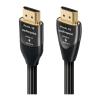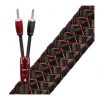To those new to the AudioQuest world, there's an air of confusion around what "directionality" means. A Google search would reveal pages and pages of educational material and long forum discussions. But there's a deeper rationale behind the arrows on AudioQuest cables. We're here to clear it out once and for all.
Understanding Directionality
First, we need to set some context. Audio-grade shielded interconnects have its own internal conductor, when compared to standard coax. The metal shield is attached to the ground at one end only. This is the prevailing method of defining a cable's directionality.
Cable manufacturers see it fit to end their job by marking the cables for directionality. But this method is incomplete, as it fails to account for conductor directionality.
But what is conductor directionality? Why did AudioQuest have to consider this factor crucial to determine overall directionality? The core idea was - noise should find direction in a manner that is least harmful. This reaffirms our belief in the advantages of controlling for the attachment of the shield.
Over time, AudioQuest's understanding about the effect of conductor directionality has improved. This reflects in the audio performance of our products over the years. How this happened - we couldn't quite explain it. But as the science developed, we could no longer rely on our ears to recognize minute details.
Diving into the science of directionality
The old test used to be to listen, then reverse the direction of the cable, and listen again. The music played would sound flat and grainy when the cable was set in one direction. The noise would, in fact, seem forced through. Reverse the direction, and the music would play the way it was meant to - with depth and ease.
A cable whose conductors were controlled for the correct low-noise directionality - you were lucky to have one of those. But the definitive empirical evidence of directionality demands seeking a scientific explanation. What is the technical explanation for directionality?
To fabricate copper or silver into a strand or conductor, it must first be cast and then drawn through a die. This process forms a directional, chevron-like pattern in the conductor’s internal grain structure and a non-symmetrical overlay of grains at the conductor’s surface.
Understanding conductor directionality has allowed us to use it to our advantage. This is evident in the way our cables stand out from the competition.
The asymmetrical surface structure creates a directional difference in impedance. This is advantageous at noise frequencies and very high interference frequencies. Due to skin-effect, such high-frequency energy travels almost exclusively on the surface of a conductor, giving significance to the directional difference in impedance at these frequencies.
Energy will always take the path of least resistance. Using this principle, when a cable is oriented so that the high-frequency noise—whether from a computer, radio station, cell tower, etc.—is “directed” to ground, or to the end of the cable attached to less vulnerable equipment, the dynamic intermodulation and associated ringing generated in the active electronics will be greatly reduced.
How AudioQuest uses directionality to their advantage
Using this understanding, all AudioQuest products maintain proper dissipation of noise. When we say all, we don't mean just our cables. For example, take the Niagara 1000 and 7000 Low-Z Power Noise-Dissipation Systems. Every single link in the conducting path is carefully controlled for low-noise directionality.
So what causes the unpleasant, strained sound? The wrong orientation of the conductors is the result of noise entering. This noise entry causes misbehavior and intermodulation in an active circuit. Less high-frequency interference is a result of cleverly utilizing conductor directionality. What this means to you, the audiophile? It means listening to music the way you were meant to, without settling for less.
As always, the proof is in the listening.
Ahh…Music!
Dubai Audio houses some of the finest speaker cables available to the audiophile world. Check them out here.
Content inspiration: AudioQuest
























